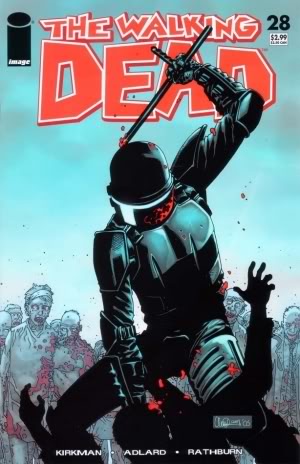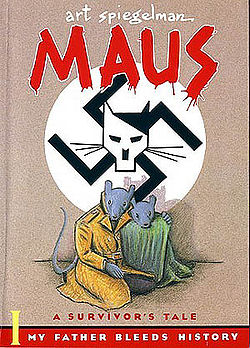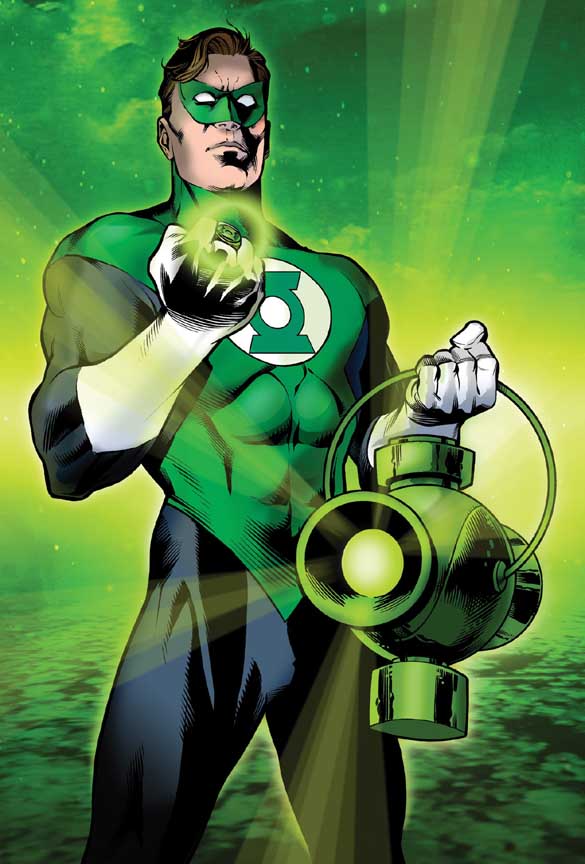‘Best’sellers
by Peter Campbell 09-Jan-11
It’s been said that you can tell the state of the nation from the books that it reads. Even if you disagree with that statement, you can certainly gauge something about people’s attitudes to the media they consume by looking at what’s currently popular. With this in mind, what information can be gleaned from Amazon’s graphic novel bestseller list as of Christmas 2010?
It’s been said that you can tell the state of the nation from the books that it reads. Even if you disagree with that statement, you can certainly gauge something about people’s attitudes to the media they consume by looking at what’s currently popular. With this in mind, what information can be gleaned from Amazon’s graphic novel bestseller list as at Christmas 2010?
At no 1 we have Simon’s Cat: Beyond the Fence by Simon Tofield. What does this tell us? It tells us that booksellers are thick. Booksellers, please note the definitions below:
- Cartoon (single drawing, with or without caption)
- Comic (sequence of drawings that create a narrative)
- Animation (seamlessly flowing series of drawings projected onto a screen)
Yes, Simon’s Cat is therefore a cartoon, not a comic. Nearly twenty five years after the breakthrough of the graphic novel into the public consciousness, booksellers are still confused as to what constitutes a comic, and quite how they should be classified. In the same spirit of confusion you’ll find The Simpsons – The Complete Episode Guide listed further down the rankings.


 Then we have: 6 entries for the Scott Pilgrim series, a whopping 17 for The Walking Dead, and a couple of entries each for Serenity, Buffy and Kick-Ass.
Then we have: 6 entries for the Scott Pilgrim series, a whopping 17 for The Walking Dead, and a couple of entries each for Serenity, Buffy and Kick-Ass.
The moral of this is, get a TV show. Or a film. Or preferably both.
No, actually the real moral is that there’s a huge, untapped audience out there, one that’s receptive to the idea of buying and reading comics. Yes, inroads have been made but the average person wouldn’t dream of buying a comic unless prompted to do so by either enormous amounts of publicity or by being drawn in via another medium. Publishers must look at the huge, huge numbers of copies sold of these titles (and I believe the Watchmen graphic novel was selling roughly 100,000 copies a month in the lead up to the release of the film) and be desperately working out how to penetrate that market more completely.
Also in the top 100 you’ll find what, or better or worse, must now be considered the classics, the core repertory of the graphic novel in the English speaking world: Maus, Watchmen, From Hell, V For Vendetta, The Dark Knight, Arkham Asylum. Most of these are over twenty years old now, and their continued popularity points towards a longevity of sorts. If media tie-ins are the means by which new readers are attracted to the medium, then one of these titles is the likely next point of investigation.
This is a new development, and it’s all to do with availability. Prior to the advent of the graphic novel, comics were ephemeral items. Their continuity lay in the popularity of their central characters, and it was only if publishers decided to reprint stories that you could gain any sense of what had gone before. It was that, or collect individual issues, in itself a difficult task prior to the advent of comic shops. That’s changed, and it allows for easier critical and popular evaluation.
Why these particular comics? They were the breakthrough graphic novels and, therefore, have had the opportunity to become the best known. And they are, in their own way, seminal works, each offering something to the medium that didn’t exist before.
There are a few other categories in the list. Wilson; Grandville Mon Amour; X-ed Out; Persepolis; Blankets. These are the prestige comics. They’re the equivalent of looking through the fiction best seller lists and spotting an Ian McEwan or Salman Rushdie lodged in there. They’re releases that bring the publishers both status and publicity, in addition to healthy sales. Give them a few years and some of them are likely to make the transition to full-fledged classics.
Then there’s the nostalgia brigade. The Collected Peanuts volumes. Charley’s War. Tintin. Black Bob. The Best of The Victor.
The remaining comics are odd blips: At the Mountains of Madness. Death Note (the first showing for manga in this list) and, a real surprise: Blacksad, the first contemporary European translated comic to make its appearance.
There are some unexpected omissions too. I’d have expected to have seen a few Sandman or Preacher titles in there. That they don’t show suggests that either they have a limited audience, or that they were products of their time and haven’t aged all that well.
What does all of this tell us? It tells us that comics are popular, but not as popular as they could be. It tells us that the audience is spilt into two types: newcomers, and a more comics literate audience who carefully pick and choose the titles they buy. That our tastes are still centred around US and UK creators, but that an appreciation of the comics being created elsewhere in the world is gradually growing.


 Now let’s look at another list. This is a list of the sales figures for comics sold through comics shops (depressingly, these days, about the only place you can get hold of them in the US).
Now let’s look at another list. This is a list of the sales figures for comics sold through comics shops (depressingly, these days, about the only place you can get hold of them in the US).
Out of the top 15 places, you have 6 Batman comics, 3 Avengers comics, 3 Green Lantern, and the remaining spots are taken up by Spider-Man, X-Men and the Flash. The best selling title has sold a little under 100,000 copies. By the time you get down to the 15th position, that number has almost halved.
The first non Marvel/DC comic appears at number 30 (Buffy). The last DC/Marvel comics are at positions 293 and 294 respectively, selling slightly under 3,000 copies each. At the very bottom, there’s the inspiringly titled Zombies vs Cheerleaders.
The first comic that doesn’t rely on a decades-old legacy of characters is at number 60: The Walking Dead. If you exclude TV/movie spin-offs and tie-ins, then you have to go to number 90 – The Boys – to find a contemporary, original series. Even then you could argue that its success is reliant on the experience of seeing thinly-disguised superhero icons in pleasurably degrading situations, and so it too depends on The Great Comic Book Legacy.
The first thing that you see when you look at this list is that the audience for comic books is much more conservative than the audience for graphic novels. They like their superheroes. And there’s nothing wrong with that, but it’s a rather restrictive view of a potentially infinitely diverse medium. There are superstar creators in the comic book world, but the impression that you get looking at this list is that it is primarily character led, rather than creator led. This is the exact opposite of the graphic novel list where, TV/movie tie-ins aside, it’s creator driven.
The sale figures are also not impressive. Really, really not impressive. Bearing in mind that The Simpsons comic sells close to 90,000 copies of each issue in the UK, then it’s very apparent that in the US the comic book shop has done as much to harm the medium as to preserve it.
There’s a huge amount of duplication as well, in the form of characters appearing in more than one comic. You might look at this and see exploitation, and you might be right. I see desperation. Times are hard, and hitting the break-even margin (of around 20,000 copies, from what I read) is difficult. If you take the current Marvel line-up, and accept that the 20,000 break-even point is true, then around 30 titles are unprofitable. So, if you have one massively successful comic, why not create a spin-off? It’ll be almost as successful, initially at least. Why not have two spin-offs, or three, or four? If you are Marvel, and your franchise is the X-Men, why not have fourteen? You know they sell. You know there’s a committed fan base. It’ll be some time before sales slack off and the book starts losing money.
Go back a decade and the sales figures of the top-selling books are not that much greater at around the 120,000 mark, but the sales figures for mid-range comics are much, much higher.
Go back 40 years, and a top-selling comic would easily be expected to sell half a million copies.
Go back 60-70 years, and a title like Superman might top five million copies sold.
What’s the difference between then and now? A different culture certainly, where the public has more and more distractions to compete for their attention. It’s also a more insular culture because the defining image of the comic book store must be Comic Book Guy in The Simpsons. If you were a general reader, and interested in picking up a comic for the first time, wouldn’t you find that a little bit off-putting?
This probably accounts for one of the reasons that new readers are attracted to graphic novels rather than the humble comic book. Graphic novels have garnered an image of respectability.
Then you have the price. Three or four dollars for a comic that takes you ten minutes to read is an awful lot of money. Back in the days when comics were sold on newsstands, then the price of a comic was ten cents. Even allowing for inflation, and rising levels of prosperity, that’s an enormous jump in cost.
Of course, that 20,000 point isn’t an absolute cut-off. Independent titles struggle by with sales of a few thousand at times. Nor are sales the only factor. Most of the Vertigo books are relatively poor sellers, but they subsidise the more lucrative graphic novels. Or they may be the source of even more lucrative merchandising deals and film adaptations.
Let’s not overstate the case – Marvel’s profit margin for the publishing division alone last year was close to 40% – but that’s the comics AND graphic novels. It’d be interesting to see what percentage of those profits came from the comic books themselves. I think it’s safe to say that, at the very least, comic books are not the force they once were. I don’t think, in fact, that it would be overstating the issue to say that the comic book as we know it is on the way out.
Cue much frantic scrabbling by the comic book companies themselves.
Marvel seems to have a fairly definite plan: take its most popular characters and reinvent them for the big screen. Churn out the graphic novels in all formats, including hugely expensive hardcover editions. DC, to a lesser degree, is following suit.
Everyone though, is looking to the web.
Yes, the web. The web is the answer to all ills. You’re reading this on the web. You most probably buy a fair chunk or all of your reading matter via the web. The web offers immediacy, and higher profit margins for relatively little outlay.
Paradoxically, it’s also the source of some of the publishers woes – file sharing of scanned comics may not be quite yet at the level of downloaded music, but it’s approaching it. What would you do if you had the opportunity – pay for a four dollar comic or read it for nothing on the internet?
So now the big gamble is on digital comics. These take two forms. Comics specifically designed to be read on your web browser (or downloaded on your iphone/android phone/mobile device of choice), and scans of existing comics.
There are disadvantages to reading web comics, and they’re to do with the limitations of the screen, and navigability. Read a web comic and, if it’s a traditionally designed comic, then the chances are that you won’t be able to see the page in its entirety: you’ll have to scroll up and down the screen and in doing so, you lose the compositional whole.
Then there’s the problem of loss of control over how you pace the reading experience: waiting for web pages to load and if you need to quickly refer back to an earlier event, it’s an even more complicated procedure.
Companies have tried to overcome this in various ways. Marvel have developed an interface that allow you to read the comics and zoom in and out of the issues that you’re looking at. It’s hideous, and unreadable. Sometimes literally unreadable. Most publishers use Comixology, which is a little more sophisticated – it gives you a preview of the page as a whole, and then breaks down the reading experience into panels, or sections of panels. You can click and drag and magnify. It’s still all very clumsily done, and it still doesn’t overcome one of the central problems: when you’re reading a comic you’re reading a section of the page, but are still peripherally aware of the overall design.
The answer, of course, is to design comics specifically for the web. Some web comics creators have taken advantage of this already, and have started experimenting with layout and (a relatively common trick) animating panels, or sections of panels. I don’t know if the latter is genuinely an improvement – the moment the images start moving, then it becomes animation. I’ve yet to see anyone really take advantage of the internet’s flexibility. If From Hell was a digital comic, for example, you could hyperlink all those lengthy annotations. Or you could play around with the narrative structure so that there isn’t a set order in which to read the comic (and then again, maybe these things have been done already, and I’m just not aware of it)
Here’s the rub though: if you make these products suitable for the web, then they’re not going to work on printed paper. And that’s still where the money really is. At the moment, sales figures for digital comics are estimated as being between half a million and a million copies yearly which, considering their lower retail price, is still insignificant in comparison to their print counterparts.
Is the comic book really dead? Of course not. But it’s dying. There are comparisons to be made with the music industry here. The single has become a loss-leader, and the physical format is dying out, mostly. The transition from physical audio format to mp3 is a small one – but for comics it’s a much greater leap. Give it time, and the difficulty in reading comics in an electronic form may be overcome, but in the process they may evolve into something else entirely.
What format will be the winner in all of this? There probably won’t be an outright winner, but the comic book will probably be the one that loses out the most.
The comic book as a physical artefact will struggle on, regardless, but mainly as a means of developing new talent, and as an advertisement for the collected editions. Sometimes they’ll make money, and sometimes they won’t. They’ll pave the way for movies, and TV series and merchandising.
Digital comics will thrive, and will take over the role that was traditionally served by printed comic books. They’re relatively cheap, and easily accessible. Once something is available in electronic form, then there’s no way of wiping out piracy, but that’s not the end of the world. Some of those readers may go on to legitimately buy comics online, and also buy printed editions.
The graphic novel readership base will continue to grow. We’re seeing it build, for the first time, a foundation of core titles, and an increased acceptability in the eyes of the public. They’ll become as diverse in their subject matter and audience as books, and, eventually, as respected. They’ll lose their cult appeal, because cult appeal lies in the periphery. In the process they may become a little bit staid, because acceptability often also seems to inhibit creativity.
And then when the dust has settled, and the future of comics seems certain, technology will evolve and give us completely different to contend with.
Really interesting feature and analysis, Peter – thanks. I did a similar thing in Christmas 2009 (though with a slightly different focus), looking at the Amazon comic charts. Skip the first half of my ramblings to get the Amazon analysis – here. For me the way to go is comics on the web supported by books, or books supported by web… I haven’t quite decided yet!
Christmas charts are always interesting to look at, because they tell us what the public’s general perception is of a particular medium (like those dreadful records you’d get from you entirely-out-of-touch grandparents when you were little). Though Amazon’s wish list scheme might skew that a bit.
Like you, I’m not sure if web or print will be the primary medium in the future, but I’m sure the two will continue to happily co-exist for the immediate future a least.
Ah, now we’re getting to the crux of the matter!
”…when you’re reading a comic you’re reading a section of the page, but are still peripherally aware of the overall design.”
One possibility is the comics equivalent of what happened to the album, which had its integrity smashed apart by i-Tunes and music just broke up into agglomerations of tracks. (Normally regarded as the reassertion of the primacy of the single, though that’s not actually quite right.) Something similar might happen to the integrity of the comics page, which just surrenders to sequences of panels.
I have to say I don’t like that idea much, though. Some track sequences work better than others, become more than the sum of their parts. Similarly, seeing those images juxtaposed has its own effect. Remember those stupid pocket books which reprinted Eisner’s Spirit a panel or two at a time? That was a dumb idea…
”I’ve yet to see anyone really take advantage of the internet’s flexibility… Or you could play around with the narrative structure so that there isn’t a set order in which to read the comic (and then again, maybe these things have been done already, and I’m just not aware of it)”
These things have, to some extent, been done already. Check out this guy. Some of his ideas work better than others, and sometimes you just get the idea. (If you know what I mean.) Other times it really cuts it.
But rather than just merging page and screen, isn’t this an opportunity to focus on what was unique about the page in the first place? Isn’t that how it normally works? Photography was supposed to kill painting, film kill the novel. Instead they liberated those old media. Painting could stop covering photography’s job of recording the world and get on with what it was good at.
As art speigelman (does he still insist on that lower case thing?) has said, comics are site-specific. The package isn’t something which surrounds the actual media, like a CD or DVD case, its part of the actual media. Chris Ware, mentioned earlier, might be a good case in point.
Like you, I’d hate for the overall primacy of the comics page to be broken up. One of the things that make comics interesting is the way that you can combine and contrast words and images within an overall larger unit. Yes, you could have individual panels, but the comics medium would lose out hugely as a result.
Technology creates all sorts of new possibilities – that web site you pointed out is pretty interesting – but web comics are going through their confused, adolescent phase at the moment, neither one thing or another. The next few years are going to be exciting ones though.
“web comics are going through their confused, adolescent phase at the moment, neither one thing or another.”
The other possibility is that they’re going through their ‘great newspaper strip’ phase, trying out all sorts of bold experiments that don’t get followed-up on, as web comics become reined in and commercialised.
Oh God, an entire internet full of the equivalent of Marmaduke and Garfield. The thought makes the blood run cold.
To misquote Orwell, if you want a vision of history, imagine a syndicated Garfield falling upon a human eye forever.
“Yes, Simon’s Cat is therefore a cartoon, not a comic.”
What does this tell us? It tells us that Peter Campbell is thick.
I’ve only flipped through a copy in a bookshop, but even by his own definition, Simon’s Cat is a comic, containing panel-to-panel storytelling.
Perhaps Peter googled the title – google seems to offer only single-panel gags from it. This doesn’t prove there aren’t sequences, but it certainly explains the assumption. (I’ve not looked at the book myself.)
I did what you did, flipped through a copy in a bookshop and didn’t see any sequential gags. It was a very cursory flick, mind you (it’s a book where the joke runs thin very quickly)